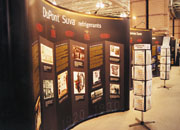When countries in Europe then moved to do away with HCFCs, the hvacr sector in the United States strongly protested such action. But that trend soon took hold here.
Now some parts of Europe are moving to do away with HFCs and using hydrocarbons (HCs) as the primary refrigerants.
“No way!” says the USA. But for the first time at an International Air-Conditioning, Heating, Refrigerating Exposition (AHR Expo), an exhibitor was promoting HC refrigerants with every intention of reaching the U.S. market through contractors.
Duracool Ltd. of Canada was represented at the 2002 show by Hi-Tech Energies (Bryantown, MD). It offered three refrigerants, each with various mixtures of propane, butane, isobutane, and other HCs. The blends were said to be “direct replacements” for use in systems originally designed to work with R-12, -22, and -502.
The company’s representatives did not reveal the percentages of each item in the blends, but said the refrigerants were pure HCs with a safety rating of A-3. They noted the products were being used in Canada in ice machines, coolers, and other closed systems, as well as in some public buildings in Canada, either in secondary-loop configurations or with set-up procedures similar to those for ammonia.

HFCs AND HCFCs
Another trend was the introduction of HFC refrigerants that exhibitors of those products contended could be used with mineral oil in retrofit applications.ICOR International (Indianapolis, IN) made its biggest push yet for its new refrigerant, NU-22. The product was called an HFC refrigerant that is “a direct replacement for R-22.” The company noted it “requires no oil change when servicing R-22-based systems,” and “is suitable for use in a variety of compressor types and compatible with standard components.” It carries an A-1 safety rating, according to the company.
Also showing HFC refrigerants that were said to work with mineral oil was Refrigerant Products Ltd. (Manchester, England). Its RS-44 was said to be usable in R-22 systems. Booth officials said the HFC blend had less than 3% isobutane and propane. The company also had RS-24, an HFC for use as an R-12 replacement without an oil change. HCs within the mix were said to be less than 2%.
HCFC-based refrigerants included those from Greencool (Beltsville, MD). Refrigerants 411B and 411C were said to work with equipment for chilled and frozen food, as well as with some air conditioning systems. The company contended that use of its refrigerants could result in increased capacity (up to 40%), a power reduction of up to 15%, and energy savings reaching 35%.
Appliance Care Products noted its affiliation with Whirlpool (Bloomington, IN) in offering interim refrigerant R-414A, which the company said could be used as a replacement for R-12. It consists of R-22, -124, and -142b, with 4% isobutane.
For the most part, major manufacturers continued to promote HFCs as a long-term solution and HCFCs as a still-viable interim option.
Atofina (Philadelphia, PA) promoted the idea of keeping HFCs as long-term refrigerants by noting that the movement to do away with the refrigerants is hardly an organized effort. In documents provided at the conference, the company cited “disagreement” on a number of global ozone issues at a conference last fall in The Hague, Netherlands.
The Kyoto Protocol, another effort to factor the global warming issue of HFCs, is “bogged down in technicalities.” At the same time, the report said, efforts are underway to “counter unilateral action against HFCs” while promoting “responsible HFC use.”
At the same time, Atofina reported on what it called “an expanded line of refrigerants.” The line included familiar long-term and interim refrigerants 134a, 404A, 507, 407C, 410A, 408A, and 409A, the latter two described by the company as “close to ‘drop-in’ replacements as possible.”
DuPont (Wilmington, DE) used the show to highlight its 200th anniversary. It noted that on July 18, 1802, French immigrant Eleuthere Irenee du Pont founded E.I du Pont de Nemours & Co. on the banks of the Brandywine River near Wilmington. For its refrigerant component, the company noted it is “preparing for the upcoming phaseout of HCFCs” and focusing on “HFCs and other alternatives to meet refrigeration and air conditioning needs.” DuPont noted that it had “eight refrigerant manufacturing facilities globally, including the world’s largest facility for HFCs.”
Honeywell Genetron (Morristown, NJ) endorsed HFCs and HCFCs, encouraged reclamation, and made attendees aware of its technical support, including bulletins, retrofit guidelines, and field presentations.
The ability to get refrigerants into the hands of contractors was a focal point at a number of booths on the show floor. Refron (Long Island City, NY) noted availability of refrigerants through 112 stocking points and touted its refrigerant management service.
Harp International (Mid Glamorgan, U.K.) noted its export services for a wide range of refrigerants.
Galco (Brussells, Belgium) featured a range of refrigerants under the Friogas name. It boasted shipping to more than 100 countries “via air, land, and sea,” out of the port city of Antwerp.
Sidebar: The Rationale Behind The Wide Range Of Oils
ATLANTIC CITY, NJ — The large number of compressor oils that contractors have to deal with was addressed on the show floor of the 2002 International Air-Conditioning, Heating, Refrigerating Exposition (AHR Expo).At the booth of Uniqema (New Castle, DE), company officials acknowledged some 30 types of oils.
The sheer number can be maddening for contractors, but officials suspected the number could drop over the years. For now, they said, compressor manufacturers are careful to specify oils that work most effectively with newer refrigerants in specific applications. They said this is to prevent system damage, as well as to optimize energy efficiency and provide acoustic control.
In a statement from the company, Chris Siemer, Global vice president for Lubricants, said, “Our lubricant customers have complex requirements owing to the wide range of reciprocating and rotating compression technologies in use and the number of HFC refrigerant blends to choose from.”
Company officials joined in with others on the show floor in encouraging contractors to contact wholesale supply houses, compressor manufacturers, and lubricant producers for assistance in deciding which oils to use. For example, Uniqema directs contractors to its expanded website (www.uniqema.com/lubricants) as a source of such information.
In other lubricant-related developments at the expo, Sporlan (Washington, MO) introduced the OL-60XH to its line of oil level controls. Features cited by the company include “the widest operating range in the industry”; standard 100-mesh inlet strainer; compact design; external adjustability; oil level equalization connection; and interchangeability with existing adapters for various types of compressors.
Henry Technologies (Melrose Park, IL) drew attention to its Optronic, which it billed as a “revolutionary oil control for scroll compressors.” Features include foam prevention and an optical (rather than mechanical) sensing device.
Witco Refined Products, available through Crompton Corp. (Greenwich, CT), featured a range of refrigeration oils, including those for HFCs.
BVA Oils (Wixom, MI) featured its Solest® oils, which the company said have exceptional miscibility with HFC refrigerants, as well as chemical and thermal stability.
Brainard Compressors (Memphis, TN) noted that its BCR refrigeration oils are wax-free and napthenic-based.
— Peter Powell
ATLANTIC CITY, NJ — Ritchie Engineering Co. Inc. (Bloomington, MN) announced that it has acquired Corrosion Consultants (Roseville, MI), a manufacturer of UV leak detection devices.
“This is an excellent addition to our existing line of Yellow Jacket® handheld electronic leak detectors, fixed monitors, and other UV scanner products,” said Steve Ritchie, president of Ritchie Engineering.
Ritchie will be marketing the leak detection technology under the Yellow Jacket label. Products include a universal fluorescent dye, a 12-V ultraviolet light (110 and 220 V also available), and a manual injector.
According to Ritchie Engineering, the 12-V UV light works at up to 20 ft away in low-light conditions, 2 ft in sunlight. The UV Blue light was designed for the hvac market, where leak testing can often take place on rooftops in bright conditions.
The Exact-dose™ injection system eliminates the use of bulky refrigerant containers, the company said.
For more information, go to www.yellowjacket.com (website).
Publication date: 02/04/2002





